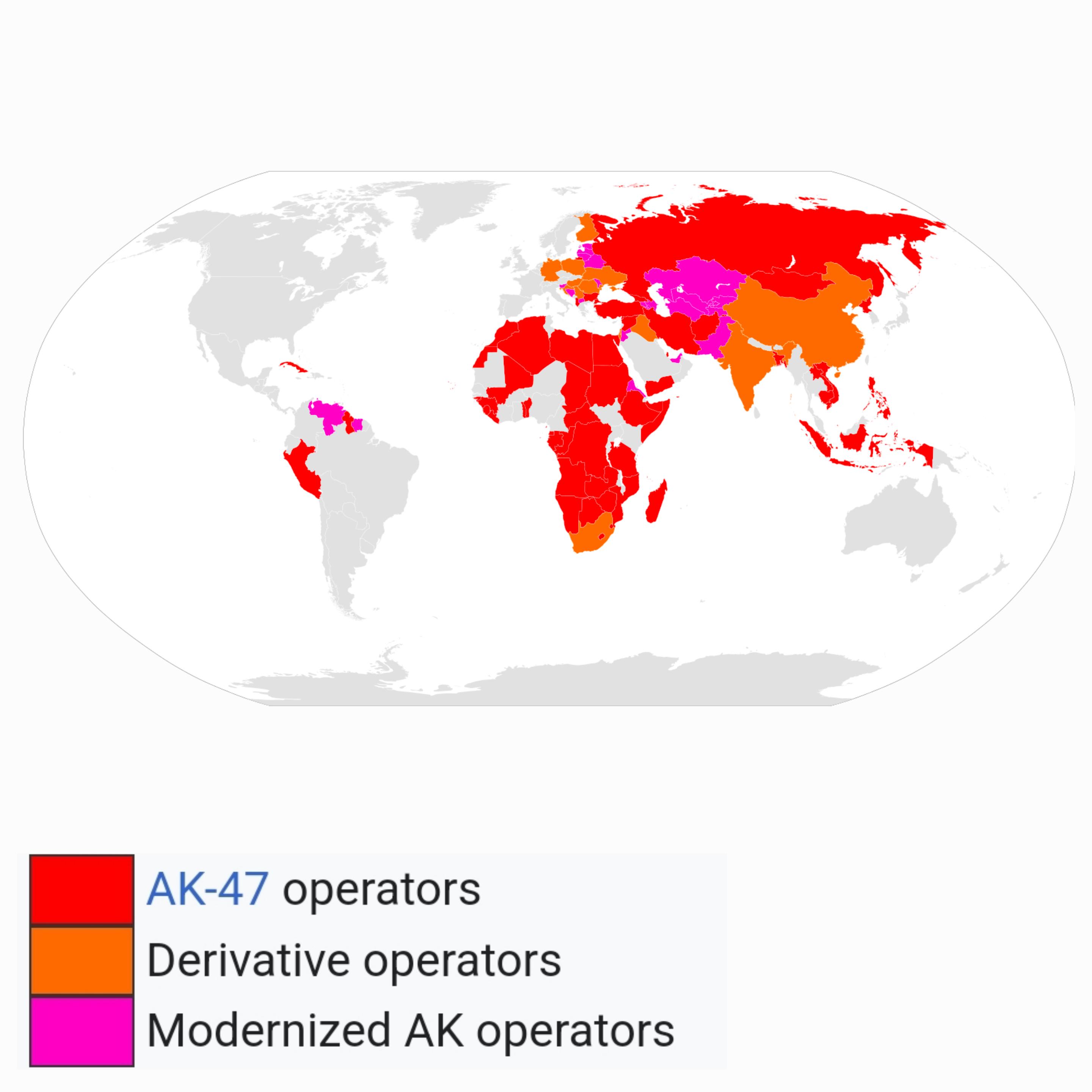AK-47 Variants and Usage Map


Alex Cartwright
Senior Cartographer & GIS Specialist
Alex Cartwright is a renowned cartographer and geographic information systems specialist with over 15 years of experience in spatial analysis and data...
Geographic Analysis
What This Map Shows
This map provides a geographic visualization of the distribution and prevalence of AK-47 models and their variants across the globe as of March 18, 2013. With the AK-47 being one of the most recognized and widely used firearms in history, this illustration highlights the areas where these firearms are most commonly found and utilized. It serves as a compelling lens into the world of small arms proliferation, military conflicts, and civilian ownership of firearms.
Deep Dive into the AK-47 and Its Variants
The AK-47, originally designed by Mikhail Kalashnikov in the late 1940s, has become an iconic symbol of warfare and resistance. As of 2004, estimates suggest that around 100 million firearms from the Kalashnikov family exist globally, with three-quarters of these being variants of the AK-47. This staggering number makes the AK-47 not only the most produced firearm in history but also a key player in the dynamics of conflict around the world.
So, what makes the AK-47 so popular? Firstly, its design emphasizes reliability and ease of use, making it particularly appealing in combat situations. The rifle is known for its durability in extreme conditions and has the ability to function effectively in harsh environments, from deserts to jungles. Moreover, the simplicity of its mechanics allows even those with minimal training to operate it efficiently.
Interestingly, the AK-47 has spawned numerous variants and copies, produced by various countries and manufacturers, adapting to different needs and contexts. Countries like China, Bulgaria, and Romania have developed their own versions, which contribute further to the staggering numbers of AK-47s in circulation. Each variant, while maintaining the fundamental design principles, often incorporates modifications suited to specific military or civilian applications.
Statistics show that the AK-47 and its derivatives have been involved in numerous conflicts worldwide, from guerrilla warfare to conventional battles. This widespread use is partly due to the availability and affordability of the weapon, which has made it accessible not only to state militaries but also to non-state actors and insurgent groups. The global diffusion of the AK-47 reflects broader issues of arms trade, conflict, and security, raising questions about regulation and control over such powerful tools.
Regional Analysis
Examining the map, we can identify several regions where AK-47s are particularly prevalent. In parts of Africa, such as South Sudan and the Democratic Republic of the Congo, the AK-47 is often seen as the weapon of choice among both military forces and rebel groups. This dominance can be attributed to the ongoing conflicts and the relative ease of obtaining such firearms in these regions.
In contrast, in Eastern Europe, the AK-47 has a historical significance, particularly in post-Soviet states where it has been integrated into national armed forces. Countries like Russia and Ukraine maintain large stockpiles of AK-47s, reflecting their historical military ties and production capabilities. The legacy of the AK-47 in these countries is not just military but cultural, symbolizing resistance and national identity in various contexts.
Interestingly, in more developed nations, the presence of the AK-47 tends to be lower in terms of military use but can still be found in civilian ownership. In the United States, for instance, there is a notable market for semi-automatic variants of the AK-47, often celebrated in the context of gun rights and personal defense, despite ongoing debates about firearm regulations.
Significance and Impact
The significance of the AK-47 and its variants extends beyond mere numbers; it raises important discussions about global security, the arms trade, and societal impacts of widespread firearm availability. The proliferation of these weapons has implications for both international relations and local communities, often exacerbating conflicts and contributing to violence.
Moreover, as we look to the future, trends indicate that the demand for the AK-47 may continue, especially in regions experiencing instability. The ongoing conflicts in parts of Africa and the Middle East suggest that the AK-47 will remain a prominent player in global arms dynamics. Efforts to regulate small arms trade and reduce violence are crucial, yet complex, given the deep-rooted presence of these firearms in various societies.
In conclusion, the AK-47 and its variants represent a significant phenomenon in both geography and global politics. Understanding their distribution and impact can offer insights into broader issues of conflict, security, and human rights. As we continue to analyze these patterns, it becomes increasingly clear that the AK-47 is not just a firearm; it is a powerful symbol of the challenges faced in a world grappling with violence and the quest for peace.
Visualization Details
- Published
- September 22, 2025
- Views
- 80
Comments
Loading comments...